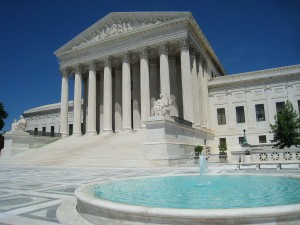Demystifying the Process of Federal Appeals: What You Need to Know
Browsing the intricate world of government appeals can frequently feel like traversing uncharted waters for those unknown with the procedure. Understanding the nuances of appellate court jurisdiction, the details of filing a notification of charm, offering a compelling short, and making a convincing oral debate are vital parts that can significantly affect the end result of a case. By deciphering the layers of complexity surrounding government charms, individuals can obtain a more clear insight into the systems that control this critical point of the lawful system.
Recognizing Federal Appeals Process
Exploring the complex realm of the government charms procedure unveils a methodical and structured trip via the judicial system. Federal charms function as a critical system for assessing decisions made by reduced courts. Comprehending this procedure is crucial for anyone associated with lawful proceedings at the federal level.
The process generally begins with an event disappointed with a reduced court's judgment filing a notice of appeal. This sets off a testimonial by a higher court, where a panel of judges analyzes the legal disagreements presented by both events. Briefs detailing the legal reasoning behind each event's position are sent, and oral disagreements may be heard to clear up complex problems.
The appellate court's choice is based on a detailed evaluation of the reduced court's procedures and the arguments provided. As soon as the appellate court reaches a choice, it can affirm, turn around, remand, or customize the reduced court's judgment, providing clearness and finality to the lawful conflict.
Appellate Court Territory Explained
Appellate court territory refers to the scope of situations that a particular appellate court has the power to evaluate and decide upon. Unlike trial courts that hear cases for the first time, appellate courts are restricted to reviewing choices made by lower courts.
Appellate courts have territory over details kinds of instances, generally those entailing lawful errors, procedural issues, or inquiries of legislation as opposed to valid conflicts. The territory of appellate courts is typically described in laws and legislations that control the court system. Understanding appellate court jurisdiction is critical for parties associated with the charms procedure as it determines whether a situation is qualified for review and the degree to which the appellate court can intervene in the lower court's choice.
Filing a Notice of Allure
The initial step in beginning the federal charms procedure involves filing a Notice of Charm with the proper appellate court. This essential paper officially notifies the court and the various other events included in the situation that the appealing event plans to seek an evaluation of the lower court's decision. Submitting a Notice of Charm is a stringent step-by-step demand that sets the appellate process moving.
When preparing the Notice of Allure, it is vital to make sure compliance with the certain guidelines and guidelines of the relevant appellate court. federal appeal lawyers. The document has to usually include information such as the instance name, the reduced court's name, the day of the judgment being appealed, and a succinct statement indicating the premises for the appeal

Instruction and Oral Disagreement
In the appellate procedure, providing created briefs and participating in dental arguments play essential roles in promoting for the appealing party's setting prior to the appellate court. Briefs are detailed lawful documents that detail the parties' disagreements, lawful authorities, and evaluation supporting their settings. These created submissions supply the court with a detailed understanding of the truths of the instance, the pertinent law, and why the appealing celebration thinks the reduced court's decision should be overturned.
Adhering to the entry and review of the briefs, oral debates supply the parties an opportunity to more clarify their settings, attend to any kind of inquiries the appellate judges might have, and highlight bottom lines from their created briefs. Oral arguments are a possibility for the lawyers to encourage the courts through verbal advocacy and reactions to queries from the bench.
Both the composed briefs and oral disagreements are critical parts of the appellate procedure, allowing parties to present their case thoroughly and compellingly before the appellate court. - federal appeal attorneys
Getting the Appellate Court Choice
Upon conclusion of oral disagreements and submission of written briefs, the next pivotal phase in the appellate procedure entails waiting for the crucial judgment from the appellate court. This period of anticipation can be loaded with a mix of anxiety and wish for events associated with the allure. The appellate court's choice is normally provided in a composed format and outlines the court's verdicts on the lawful problems presented, the reasoning behind their choice, and the judgment made. The time framework for receiving the appellate court's choice can vary, however courts strive to supply timely resolutions. Once the choice is provided, parties must meticulously examine the court's ruling to understand the end result and determine any kind of additional steps that might be needed. Whether the appellate court affirms, turns around, or remands the lower court's decision, recognizing the implications of the judgment is vital for all parties associated with the appellate process. Quickly assessing and comprehending the appellate court's choice is important in browsing the next actions in the lawful proceedings.
Verdict
To conclude, the federal charms procedure is a complex but vital action in looking for justice. Comprehending the appellate court territory, submitting a notification of appeal, preparing briefs, and presenting oral disagreements are all crucial parts of this procedure. Ultimately, receiving the appellate court decision can offer clearness and resolution to lawful disagreements. It is essential to browse the government appeals procedure with diligence and attention to detail to achieve a fair result.
As we proceed from recognizing the government charms process to dissecting the intricacies of appellate court jurisdiction, a fundamental facet comes to light pertaining to the authority and restrictions of these higher courts in the lawful landscape. Appellate court territory refers to the range of instances that a next specific appellate court has the power to examine and determine upon. Unlike trial courts that hear instances for the first time, appellate courts are restricted to assessing choices made by reduced courts. Understanding appellate court jurisdiction is crucial for events included in the appeals procedure as it figures out whether a situation is eligible for testimonial and the degree to which the appellate court can intervene in the reduced court's decision.

Comments on “Why Choose Federal Appeal Lawyers: Proven Strategies for Effective Appeals”